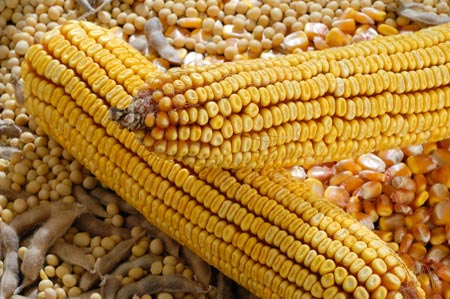 (Reuters) – U.S. corn stocks fell to the lowest level in eight years at the end of the 2011/12 season (Sept-Aug) even as the early harvest of this year’s crop pumped more than 1 billion bushels of the grain into the supply pipeline, analysts polled by Reuters said.
(Reuters) – U.S. corn stocks fell to the lowest level in eight years at the end of the 2011/12 season (Sept-Aug) even as the early harvest of this year’s crop pumped more than 1 billion bushels of the grain into the supply pipeline, analysts polled by Reuters said.
The 17 analysts surveyed expected the U.S. Department of Agriculture’s quarterly stocks report on Friday to show stocks as of September 1 – also the ending stocks for the 2011/12 marketing year – at 1.113 billion bushels.
The tally would be down 15 million bushels from a year ago and the lowest supply of corn on that date in eight years, since 958 million bushels in 2003/04. In its September 12 supply/demand report, USDA pegged 2011/12 ending stocks at 1.181 billion.
The worst drought in half a century devastated this year’s corn and soybean crops, rallying prices to all-time highs this summer, although prices have eased 10 to 12 percent since.
But the early harvest of this year’s corn crop has raised questions over how much of those supplies were used in the 2011/12 season, when old-crop supplies were considered to be tight and prices were high.
“The quick maturity and fast harvest I think brought over 1.0 billion bushels to market before the end of the crop year and that’s going to complicate things,” said Shawn McCambridge, analyst for Jefferies Bache, whose stocks estimate of 1.261 billion bushels was the highest of the 17 analysts’.
The estimates ranged from 887 million to 1.261 billion bushels. Executive Vice President Roy Huckabay of the Linn Group had the lowest estimate at 887 million, and said he was not accounting for any of the early harvested corn harvested.
Chicago Board of Trade corn futures hit a record high of $8.49 on August 10, denting demand from both the export market and livestock and ethanol sectors.
U.S. corn export shipments in the 2011/12 season totaled about 37.9 million metric tons (1.49 billion bushels), according to USDA, below the full-season forecast of 39.12 million metric tons (1.54 billion bushels). USDA said 1.667 million metric tons of 2011/12 sales were carried over to the next marketing year.
The soaring prices began rationing demand and the early harvested crop added bushels to stocks as of the September 1 quarter, which could lead to extreme price volatility if the USDA’s estimate varies significantly from trade expectations.
The quarterly stocks data for corn has been a source of much volatility in the markets for about two years.
“The September grain stocks report has turned into quite a crapshoot. While most of the surprises focused on corn the last two years, there’s also uncertainty for soybeans and wheat,” said Bryce Knorr, Senior Editor for Farm Futures Magazine.
The Reuters poll showed U.S. wheat stocks on September 1 at 2.278 billion bushels, up from 2.147 billion a year ago, and soybean stocks at 131 million, down from 215 million a year ago.
“USDA likely tried to downplay this potential for corn by tipping its hand in the September 12 report, saying new-crop usage was greater than normal. Still, the trade believes these estimates tend to commingle both old and new crop,” Knorr said.
“Many traders may try to ignore these numbers but if high frequency traders trade the headlines, it could make for a lot of volatility,” Knorr said.
ANALYSTS SPLIT ON CHANGE IN SOY STOCKS FROM SEPT. 12
U.S. September 1 soybean stocks should fall to 131 million bushels, according to the average analyst estimate, the lowest level since 112 million in 2003/04. The figure was nearly unchanged from the 130 million bushels that USDA forecast earlier this month for 2011/12 soy ending stocks.
Trade estimates ranged from 110 million to 152 million bushels, and analysts were evenly split on whether the figure should fall above or below what USDA forecast for ending stocks on September 12.
Those at the low end of the range said a strong pace of U.S. soybean exports should have drawn down supplies.
“I think export demand was surprisingly good. The number of beans shipped, combined with the amount of meal that was shipped, should leave us with a fairly tight supply,” said Sterling Smith, futures specialist with Citigroup, who pegged September 1 soybean stocks at 115 million bushels.
Others predicted a higher figure. Like corn, the U.S. soybean harvest got off to an early start. But with only 4 percent of the U.S. soy harvest complete by September 9, and even less by September 1, “commingling” of the old and new crops should be less of an issue with soybeans.
Jefferies Bache oilseeds analyst Anne Frick, who gave the highest estimate of September 1 soybean stocks at 152 million bushels, said a more likely scenario was that USDA undercounted the 2011 soybean harvest.
“My guess is (USDA) could find another 30 million bushels, either by revising upward last year’s crop or even by revising upward last September’s stocks, which could happen,” said Frick.
She said the strong usage pattern of U.S. soybeans during the past quarter, coupled with USDA’s unusually small forecast for 2011/12 soybean “residual” use, suggest that “actual carryover stocks were probably higher than we thought they were on paper.”
“I’m thinking that there is more likely to be a bearish surprise than a bullish surprise in the report,” Frick said.
(Reporting By Sam Nelson and Julie Ingwersen; Editing by Gary Hill)




